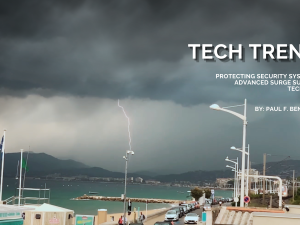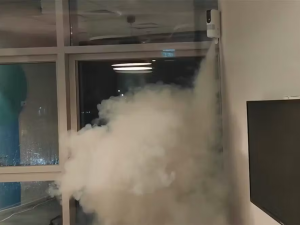This may seam like an odd topic for the Tech Trends column, but any of you reading this know that you have seen countless “fails” in security technology installations. If we are honest, some of these fails are within organizations we have responsibility to. After decades in the business assessing countless facilities and their security technology, I have clearly identified some tech trends that are actually hurting our industry, our customers, and frankly, putting lives at stake.
I see clients who have spent millions of dollars on feature-rich security technology. The need gets established, the budget approved, and the technology installed, only to be far less effective than what was originally intended or capable. Meanwhile, those in upper management believe that their facility is more secure because of the big spend they approved.
This, unfortunately, is a common trend; they bought the Ferrari and use it like a 1974 Ford Pinto. Here are identified 5 of the most common trends I see in the field:
1. Underperforming or unused technology:I often hear: “It worked well at the trade show when I saw it, but it does not work in our environment” or “it was never programmed” or “wait, our system can do that?”
The manufacturer, consultant or integrator told the customer about the wonderful things that can be done with the system and its features; however, just a year into operating the system, those features were totally forgotten, never used, or only partially implemented. Why? Sometimes they are easier to sell and harder to implement; other times, no one was watching what was owed to the customer; or worse, the customer was never trained, or the feature was more cumbersome than effective to operate so it was turned off.
2. Poor trade coordination and workmanship: This issue is most significant in access control and door hardware. Typically, doors, frames and hardware are the responsibility of the facilities department, and the electronic access control system is serviced by the security integrator. Its very common for high-traffic doors to require regular maintenance, and the frequent use of these type of doors often put hardware out of alignment, damage jambs, and other door components.
Poor coordination between the facilities department and security leaves a gap that ultimately can leave a facility unsecured. The security vendor may discover a damaged door that does not allow it to properly secure, but the access control system is technically working. The internal coordination with a facilities department can easily get lost or assigned a lower priority to fix.
3. Insufficient video recording parameters:Shortsightedness regarding frame rate, resolution, retention, and recording methods often undercut the evidentiary requirements needed to support investigations. In order to save storage, system recording parameters are set to motion only and lower frame rate. While this does accomplish the goal of reducing the overall storage requirements of a system, it can have significant negative impact. In doing so you can lose scene continuity, where the camera’s angle to the subject does not capture motion and therefore the recording does not activate or stops early.
A perfect example of this was in a school where two individuals were in an altercation, the one subject had the other against a wall of lockers and was accused of repeatedly punching the other in the abdomen. The camera only recorded the individual running away from the lockers, because the subject’s repeated punching movements were blocked from the camera’s field of view. Had this system been set to record at a minimum of 1fps continuously and then increase the frame rate on motion, scene continuity would have been preserved.
4. No budget for service, support and end-of-life migration: This is especially prevalent in new facilities where the systems were designed and installed prior to the owners’ operations team taking possession of the facility. The cost of ongoing system maintenance, support, and replacement of equipment is not budgeted, and therefore the system falls into disrepair.
This opens the customer’s systems to security vulnerabilities where software and firmware are missing critical patches and updates, and performance criteria are not maintained. When this happens on a public project, it can become more complex – as low bid RFPs often dictate the next servicing vendor, and they typically do not have legacy knowledge of the systems.
5. Lack of training: One of the most critical of all the trends I see is that system users have limited proficiency in the operation of the systems, especially under duress. Most users get basic “point-and-click” training where they learn general system navigation and operations. This is done when the system is turned over to the owner, but thats about the depth of the training. This is particularly true in schools where the operation of video surveillance and access control systems during emergencies default to personnel in the main office, while the regular system users like the SRO and administrators tend to the emergency. Its very rare that we find end users that have been trained to use their systems under duress in a tactical capacity.
What to do as an Industry
Each of these trends can be mitigated if integrators and consultants step in to fill the gap. We need to pursue excellence at all levels – from manufacturing and design, to installation, training and support.
We must clearly identify the performance objectives in normal and emergency conditions, and to ensure that technology meets those objectives. Further, regular training, and system audits should be conducted to ensure that both the human and technology elements of a system are conditioned to use the technology when it matters most.
In light of events such as school shootings, we must ask ourselves: What good does all of this technology do if it does not stop the threat? Do I need 240 cameras to cover a school if it does nothing to stop or reduce the impact of an assailant?
There is no room for excuses. Like an airbag in a car, smoke detector, or parachute it needs to work 100% of the time, correctly. If the systems we are providing are too complex, we need to put an emphasis on automation and support training until it becomes second nature, as well as regular testing of the systems so it will perform when needed most.
Article Link – https://www.securityinfowatch.com/integrators/article/21271623/tech-trends-technology-fails-and-how-to-avoid-them
This article originally appeared in the July 2022 issue of Security Business magazine. Paul F Benne is the President of Sentinel Consulting and has over 35 years in the protective service industry.







